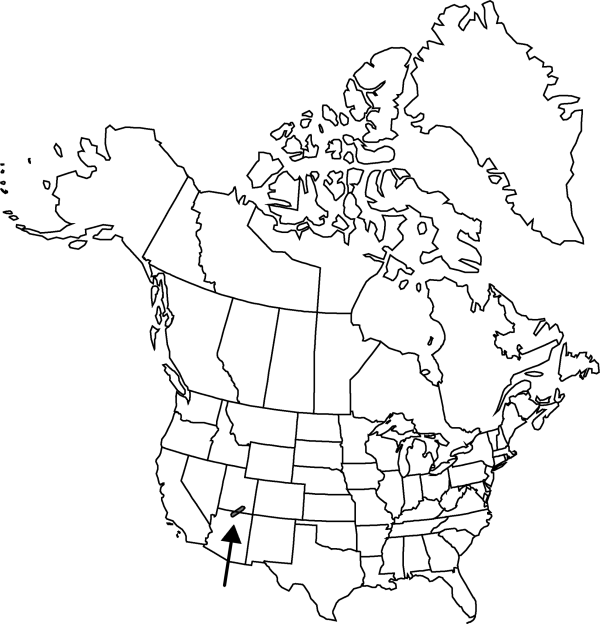Difference between revisions of "Opuntia polyacantha var. nicholii"
Cact. Succ. J. (Los Angeles) 70: 188. 1998.
Common names: Navajo Bridge pricklypear
Endemic
Basionym: Opuntia nicholii L. D. Benson Cacti Arizona ed. 2, 48. 1950
Synonyms: Opuntia hystricina var. nicholii (L. D. Benson) Backe berg
Treatment appears in FNA Volume 4. Treatment on page 147.
FNA>Volume Importer |
imported>Volume Importer |
||
| (7 intermediate revisions by 2 users not shown) | |||
| Line 8: | Line 8: | ||
}} | }} | ||
|common_names=Navajo Bridge pricklypear | |common_names=Navajo Bridge pricklypear | ||
| − | |basionyms={{Treatment/ID/ | + | |special_status={{Treatment/ID/Special_status |
| + | |code=E | ||
| + | |label=Endemic | ||
| + | }} | ||
| + | |basionyms={{Treatment/ID/Basionym | ||
|name=Opuntia nicholii | |name=Opuntia nicholii | ||
|authority=L. D. Benson | |authority=L. D. Benson | ||
| + | |rank=species | ||
| + | |publication_title=Cacti Arizona ed. | ||
| + | |publication_place=2, 48. 1950 | ||
}} | }} | ||
|synonyms={{Treatment/ID/Synonym | |synonyms={{Treatment/ID/Synonym | ||
|name=Opuntia hystricina var. nicholii | |name=Opuntia hystricina var. nicholii | ||
|authority=(L. D. Benson) Backe berg | |authority=(L. D. Benson) Backe berg | ||
| + | |rank=variety | ||
}} | }} | ||
|hierarchy=Cactaceae;Cactaceae subfam. Opuntioideae;Opuntia;Opuntia polyacantha;Opuntia polyacantha var. nicholii | |hierarchy=Cactaceae;Cactaceae subfam. Opuntioideae;Opuntia;Opuntia polyacantha;Opuntia polyacantha var. nicholii | ||
| Line 23: | Line 31: | ||
}}<!-- | }}<!-- | ||
| − | --><span class="statement" id="st- | + | --><span class="statement" id="st-undefined" data-properties=""><b>Stem </b>segments narrowly to broadly obovate, 10–27 × 7–18 cm; areoles 8–11 per diagonal row across midstem segment, 12–30 mm apart. <b>Spines</b> in most areoles, of 2 kinds: major spines 1–5 per areole, down curved, ascending near stem segment apex, pink-gray or basal 2/3 brown to black, the longest 45–150 mm; minor spines 3–8 per areole, deflexed, white to gray, 60–220 cm (spine clusters easily detached in preparing specimens). <b>Fruits</b> stout; areoles 18–24, most bearing 3–12 spines, 8–17 mm. <b>2n</b> = 66.</span><!-- |
-->{{Treatment/Body | -->{{Treatment/Body | ||
| + | |phenology=Flowering spring. | ||
|habitat=Barren areas with saltbush and ephedra, limestone or red, sandy soils | |habitat=Barren areas with saltbush and ephedra, limestone or red, sandy soils | ||
|elevation=1200-1300 m | |elevation=1200-1300 m | ||
| Line 37: | Line 46: | ||
-->{{#Taxon: | -->{{#Taxon: | ||
name=Opuntia polyacantha var. nicholii | name=Opuntia polyacantha var. nicholii | ||
| − | |||
|authority=(L. D. Benson) B. D. Parfitt | |authority=(L. D. Benson) B. D. Parfitt | ||
|rank=variety | |rank=variety | ||
| Line 44: | Line 52: | ||
|basionyms=Opuntia nicholii | |basionyms=Opuntia nicholii | ||
|family=Cactaceae | |family=Cactaceae | ||
| + | |phenology=Flowering spring. | ||
|habitat=Barren areas with saltbush and ephedra, limestone or red, sandy soils | |habitat=Barren areas with saltbush and ephedra, limestone or red, sandy soils | ||
|elevation=1200-1300 m | |elevation=1200-1300 m | ||
| Line 50: | Line 59: | ||
|publication title=Cact. Succ. J. (Los Angeles) | |publication title=Cact. Succ. J. (Los Angeles) | ||
|publication year=1998 | |publication year=1998 | ||
| − | |special status= | + | |special status=Endemic |
| − | |source xml=https:// | + | |source xml=https://bitbucket.org/aafc-mbb/fna-data-curation/src/2e0870ddd59836b60bcf96646a41e87ea5a5943a/coarse_grained_fna_xml/V4/V4_286.xml |
|subfamily=Cactaceae subfam. Opuntioideae | |subfamily=Cactaceae subfam. Opuntioideae | ||
|genus=Opuntia | |genus=Opuntia | ||
|species=Opuntia polyacantha | |species=Opuntia polyacantha | ||
|variety=Opuntia polyacantha var. nicholii | |variety=Opuntia polyacantha var. nicholii | ||
| − | |||
| − | |||
| − | |||
| − | |||
| − | |||
| − | |||
| − | |||
| − | |||
| − | |||
| − | |||
| − | |||
| − | |||
| − | |||
| − | |||
| − | |||
| − | |||
| − | |||
| − | |||
| − | |||
| − | |||
| − | |||
}}<!-- | }}<!-- | ||
-->[[Category:Treatment]][[Category:Opuntia polyacantha]] | -->[[Category:Treatment]][[Category:Opuntia polyacantha]] | ||
Latest revision as of 22:57, 5 November 2020
Stem segments narrowly to broadly obovate, 10–27 × 7–18 cm; areoles 8–11 per diagonal row across midstem segment, 12–30 mm apart. Spines in most areoles, of 2 kinds: major spines 1–5 per areole, down curved, ascending near stem segment apex, pink-gray or basal 2/3 brown to black, the longest 45–150 mm; minor spines 3–8 per areole, deflexed, white to gray, 60–220 cm (spine clusters easily detached in preparing specimens). Fruits stout; areoles 18–24, most bearing 3–12 spines, 8–17 mm. 2n = 66.
Phenology: Flowering spring.
Habitat: Barren areas with saltbush and ephedra, limestone or red, sandy soils
Elevation: 1200-1300 m
Discussion
Selected References
None.
Lower Taxa
None.
